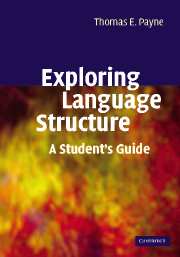Book contents
- Frontmatter
- Contents
- List of figures
- List of tables
- Preface
- Acknowledgments
- A note on transcriptions
- List of abbreviations
- 1 Introduction to morphology and syntax
- 2 Morphological processes and conceptual categories
- 3 Morphophonemics
- 4 Word classes
- 5 Exploring subclasses
- 6 Constituent structure
- 7 Language typology
- 8 Grammatical relations
- 9 Voice and valence
- 10 Multi-clause constructions
- Glossary
- References
- Subject and language Index
10 - Multi-clause constructions
Published online by Cambridge University Press: 05 June 2012
- Frontmatter
- Contents
- List of figures
- List of tables
- Preface
- Acknowledgments
- A note on transcriptions
- List of abbreviations
- 1 Introduction to morphology and syntax
- 2 Morphological processes and conceptual categories
- 3 Morphophonemics
- 4 Word classes
- 5 Exploring subclasses
- 6 Constituent structure
- 7 Language typology
- 8 Grammatical relations
- 9 Voice and valence
- 10 Multi-clause constructions
- Glossary
- References
- Subject and language Index
Summary
In every language there exist different ways of combining basic clauses to form more complex structures. In this chapter we will discuss several construction types that involve combinations of clauses.
Most of the constructions described in this chapter involve two clauses – one independent clause and one or more dependent clauses. An independent clause is one that is fully inflected and capable of being used in discourse on its own. A dependent clause is one that depends on some other proposition for at least part of its inflectional information. For example, in the following construction, clause 1b is dependent on clause a because the subject and tense of clause b are only understood via the subject and tense of clause a:
(1) a. He came in, b. locking the door behind him.
Clause 1b by itself cannot naturally be used in discourse on its own. Sometimes fully inflected verbs are called finite verbs, whereas dependent verbs are termed non-finite. However, this distinction must be understood as a continuum, as some verbs may be dependent in one respect, but independent in another. Thus we may talk about one verb being more finite or less finite than another.
The following discussion will be organized according to six general construction types: (1) serial verbs, (2) complement clauses, (3) adverbial clauses, (4) clause chains, (5) relative clauses, and (6) coordination. These six construction types are arranged in such a way that the earlier ones represent relatively “tight” grammatical integration between two verbs or clauses, whereas the later ones represent “looser” grammatical integration.
Information
- Type
- Chapter
- Information
- Exploring Language StructureA Student's Guide, pp. 288 - 319Publisher: Cambridge University PressPrint publication year: 2006
